Before I get into this, let me give proper thanks for the info and pictures from
zenseeker.net, toyotavantech (theMan) and Uri of Previadiaries.wordpress.com
These sources really put pictures and what they did out there.. so now I 'm going to jumble them all together as I am going to do these cleans soon!
----------------------------------------------

After spending a pretty penny and 2 months having the motor rebuilt. I kept reading about the black flakes in the coolant..
I mentioned this to the shop that I had my van worked on. At on point, I asked for the throttle body and IAC valve as it was just sitting there, but got the "dont worry about it, we'll take care of it". I even showed some blogs of that covered this issue.
After getting the van back... boom, check engine light and the shop ran the code.
In all honesty, I was kinda upset that they did not cover this part, even after I had mentioned it.
P0401 Error Code: "Exhaust Gas Recirculation Flow Insufficient Detected"
--------------------------------------------------------------------------------------------------

TheMan's post:
I took off the throttle body and cleaned it. It has never been cleaned and the photos below is proof of that! It was such a pain to remove as there is little room to work with. I detached all of the vacuum hoses then unbolted the throttle cable linkage from the throttle body. The hardest part was removing the air inlet hose and the 3 rubber hoses clamped onto the idle valve from below. Lots of dirt rained on me and once I pulled the hoses off, coolant rained all over me! After about 2 hours, I finally got it off, just as it started to rain.
Not a problem since I was planning to clean the throttle in my garage
anyway, away from the sun/rain.
After about 2 hours, I finally got it off, just as it started to rain.
Not a problem since I was planning to clean the throttle in my garage
anyway, away from the sun/rain. 
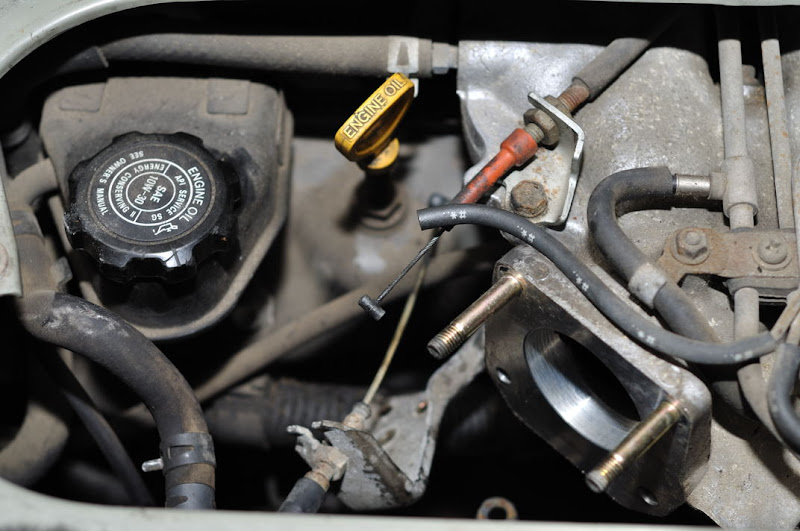


I built a jig to support the throttle body safely without damaging the vacuum hose fittings then I removed the idle valve assembly from the throttle body using an impact driver. The 4th screw wouldn't budge so I had to get the drill out I anticipated this beforehand and ordered new screws. This was a wise decision after all and saved me from downtime!
I anticipated this beforehand and ordered new screws. This was a wise decision after all and saved me from downtime!


The idle valve was so gummed up with carbon that the vane would not move much at all! I flushed it down with carb cleaner then lubricated the shafts with some Wurth HHS2000 lubricant. Moved nice and smoothly afterward.
After using a full can of carb cleaner, the insides are good as new!

I then reassembled the throttle body and reinstalled it to the engine while in the dark. Wasn't fun at all especially since the ground was still wet from the rain!
And finally, I refilled the cooling system using Ford Motorcraft VC-5 coolant (comes in a 1 US gallon jug) as it has low silicates and mixed it with 6 litres of distilled water. This was more usual because I removed the heater hose and the throttle body which drained out a little more coolant. I added a bottle of Holts Radweld as a precautionary measure (to prevent any external head gasket leaks like seen on some cars) and an ounce of Redline Diesel Water Wetter to improve cooling efficiency.
It now idles much better, no longer does the mirrors shake while the aircon is on while idling in gear! The high idle cold starts are back! It never really idled above 1000rpm for many years now. Next thing to do sometime in the next few months is to carbon clean the intake system using an induction cleaner.
----------------------------------------------------------
PREVIADIARIES POST
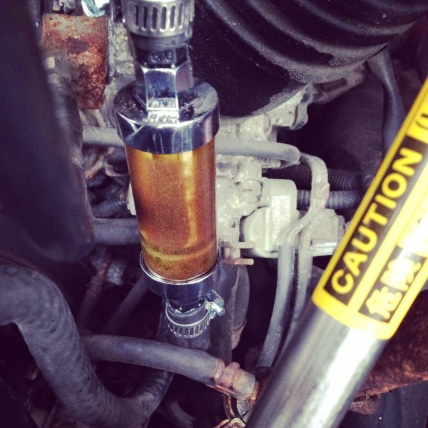
Indeed it did.
A side effect of the filthy coolant is a tendency for these vans to end up with a high idle. Basically, the IACV (idle air control valve) judges whether the engine is cold by the coolant temperature, and if it’s cold, it raises the idle until the optimal operating temperature is reached. A narrow opening leading to the sensor can get gunked up pretty easily with the black flakes of hose that made their way there in the filthy coolant, and as a result, the IACV never actually senses the temperature of the coolant and never thinks the engine is up to operating temperature, resulting in a wacky high idle.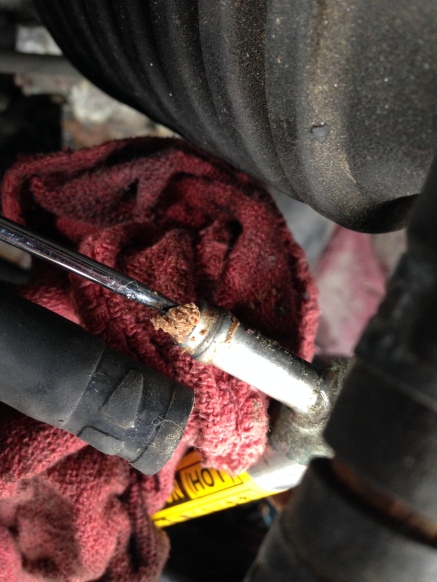
I had already cleaned out black flakes (which were really more hamburger colored in this case) and rebuilt the IACV on TGO and didn’t actually get around to posting about it, but it gets a second chance since it’s going in TRO. While TRO already had some black flakes in the crucial T-junction, TGO hadn’t so I knew the dysfunction must have lived deeper down. I ordered a new gasket for it and got some carb cleaner, which you know is the good stuff since it’s banned in California, and got to work. While I can’t explain the chemical reaction that made this goop happen, it had definitely happened long enough ago that it wasn’t easy to get it out.
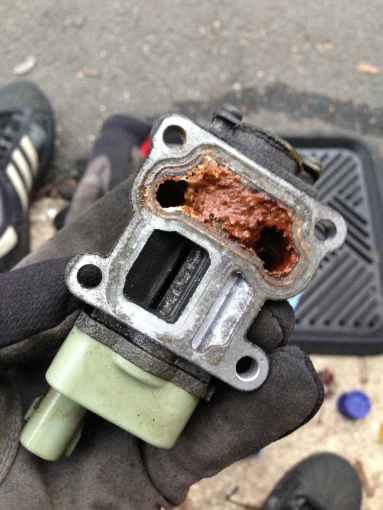
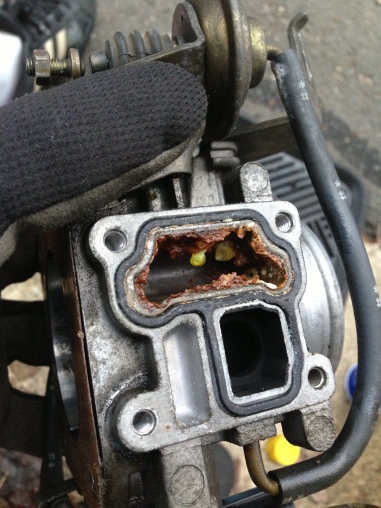
After some elbow grease and probably a lot of inhaled carb cleaner, I got the valve clean, and put it back together, which seemed to help, if not resolve the idle issues.
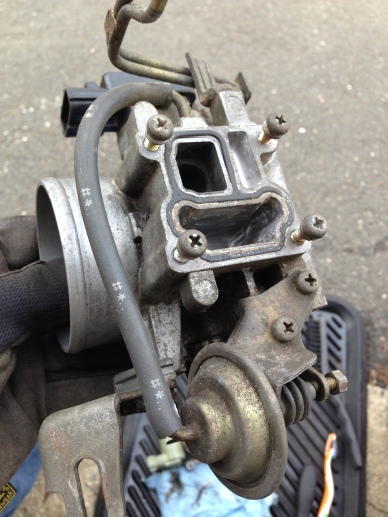
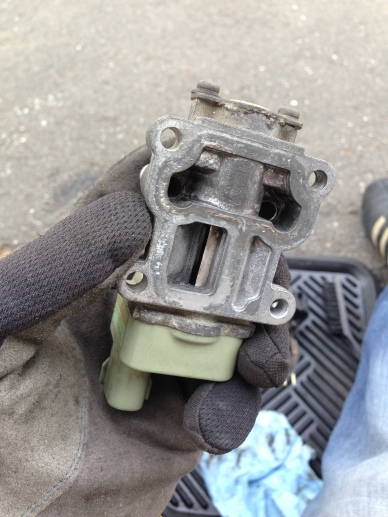
------------------------------------------------------------------
ZENSEEKER'S DIY PICS!!!
zenseeker.net, toyotavantech (theMan) and Uri of Previadiaries.wordpress.com
These sources really put pictures and what they did out there.. so now I 'm going to jumble them all together as I am going to do these cleans soon!
----------------------------------------------

After spending a pretty penny and 2 months having the motor rebuilt. I kept reading about the black flakes in the coolant..
I mentioned this to the shop that I had my van worked on. At on point, I asked for the throttle body and IAC valve as it was just sitting there, but got the "dont worry about it, we'll take care of it". I even showed some blogs of that covered this issue.
After getting the van back... boom, check engine light and the shop ran the code.
In all honesty, I was kinda upset that they did not cover this part, even after I had mentioned it.
P0401 Error Code: "Exhaust Gas Recirculation Flow Insufficient Detected"
The pesky EGR code. The code means that your computer isn't
getting a proper EGR Gas Temp on the intake manifold.
Probable causes in SC Previa:
| EGR to Throttle passage clogged | Most likely - This gets clogged. Remove throttle body and EGR and flush out | ||
| VALVE ASSY, EGR. | 2562076020 | Hook up vacuum to hose while engine running. If no change in RPM, the EGR is faulty or exhaust tubes are clogged. Clean out or Replace | |
| VALVE ASSY, EGR VACUUM MODULATOR. | 2587076040 | Filter can get clogged - clean or replace | |
| Lost vacuum | blow out all tubes and hoses. Look for leaks. Run brake cable through long tubes or replace with long hose if you can't clean out | ||
| PIPE SUB-ASSY, EGR, NO.1. | 2560176010 | Unlikely - clogged and needs to be cleaned | |
| SENSOR, E.G.R GAS TEMPERATURE | 8941228010 | Clean or replace | |
| VALVE ASSY, VACUUM SWITCHING, NO.1. (aka VSV) - SC Previa | 2586075070 | This switch supplies vacuum to your EGR. Test
and replace if needed - also found on 94-98 T100. Test by blowing
air through mid tube -
should blow out back of VSV with no power should blow out other tube of VSV WITH power |
|
| VALVE ASSY, BIMETAL. (aka Thermal Vacuum Valve, TVV and BVSV) - Non SC Previa | 2582076010 | This switch supplies vacuum to your EGR. Test
and replace if needed. Test by blowing air through one hole -
if engine cold - no air flow if engine hot (133F 56C) - air flow |
|
| ECU | sigh | ||
| Give up | toyotanation.com 366398-egr-code-ecu-fake-outl |
"I found these pictures on the Yahoo Previa Forum. The filter should be
installed with the filter arrow toward the tee. I used toothpicks and
Q-tips to clean my tee out. If you have a small mirror you can use it to
look inside the tee to see if you got all the flakes."


Supercharged Previas have a long ventilation tube which
connects
the oil filler neck under the driver's seat to the air tube connected to
the mass air
flow sensor. This ventilation tube is double walled with hot coolant
flowing from the throttle body to the top of the outer part of the
ventilation
tube to under the Previa on the left side of engine and then connects to
a hose on its way to the EGR(???). The inner part of this ventilation
tube brings crankcase gasses
to the air tube connecting the mass air flow sensor and throttle body.
Black
flakes will collect in the upper "T" where coolant enters this
ventilation tube.
This can clog the tube and lead to high idles when it's cold out since
warm
coolant isn't flowing through the throttle body. The solution is to
clean
out the black flakes and blow out any clogs from the bottom with
compressed air. If this fails, you
may need to replace the tube altogether or reroute your coolant lines.
If
you reroute your coolant lines, you may need to frequently clean out the
ventilation tube with SeaFoam or other solvent safe for your engine.
If once you unclog your coolant lines, you may wish to consider a
in-line filter to protect your coolant system.

TUBE SUB-ASSY, VENTILATION. Toyota PN 1220176020
-------------------------------------------------------------------------TheMan's post:
I took off the throttle body and cleaned it. It has never been cleaned and the photos below is proof of that! It was such a pain to remove as there is little room to work with. I detached all of the vacuum hoses then unbolted the throttle cable linkage from the throttle body. The hardest part was removing the air inlet hose and the 3 rubber hoses clamped onto the idle valve from below. Lots of dirt rained on me and once I pulled the hoses off, coolant rained all over me!



I built a jig to support the throttle body safely without damaging the vacuum hose fittings then I removed the idle valve assembly from the throttle body using an impact driver. The 4th screw wouldn't budge so I had to get the drill out


The idle valve was so gummed up with carbon that the vane would not move much at all! I flushed it down with carb cleaner then lubricated the shafts with some Wurth HHS2000 lubricant. Moved nice and smoothly afterward.
After using a full can of carb cleaner, the insides are good as new!

I then reassembled the throttle body and reinstalled it to the engine while in the dark. Wasn't fun at all especially since the ground was still wet from the rain!
And finally, I refilled the cooling system using Ford Motorcraft VC-5 coolant (comes in a 1 US gallon jug) as it has low silicates and mixed it with 6 litres of distilled water. This was more usual because I removed the heater hose and the throttle body which drained out a little more coolant. I added a bottle of Holts Radweld as a precautionary measure (to prevent any external head gasket leaks like seen on some cars) and an ounce of Redline Diesel Water Wetter to improve cooling efficiency.
It now idles much better, no longer does the mirrors shake while the aircon is on while idling in gear! The high idle cold starts are back! It never really idled above 1000rpm for many years now. Next thing to do sometime in the next few months is to carbon clean the intake system using an induction cleaner.
----------------------------------------------------------
PREVIADIARIES POST
IACV transfer and beats
Supercharged Previas like mine have an extra 25 hp out of the factory compared to the naturally aspirated variants (135 vs 160), but along with that power boost came a bunch of extra complexity beyond the nearly inaccessible supercharger itself. There’s a different radiator with extra holes, and those extra holes go to extra plumbing elsewhere. All this extra plumbing means more hoses to breakdown over 20 years, which means the coolant in these vans often ends up, as Chris Plummer pointed out, “looking like assbarf.” I decided to put a Mr. Gasket clearview fuel filter in the coolant line leading to the IACV to see if TRO had the same problem.
Indeed it did.
A side effect of the filthy coolant is a tendency for these vans to end up with a high idle. Basically, the IACV (idle air control valve) judges whether the engine is cold by the coolant temperature, and if it’s cold, it raises the idle until the optimal operating temperature is reached. A narrow opening leading to the sensor can get gunked up pretty easily with the black flakes of hose that made their way there in the filthy coolant, and as a result, the IACV never actually senses the temperature of the coolant and never thinks the engine is up to operating temperature, resulting in a wacky high idle.

I had already cleaned out black flakes (which were really more hamburger colored in this case) and rebuilt the IACV on TGO and didn’t actually get around to posting about it, but it gets a second chance since it’s going in TRO. While TRO already had some black flakes in the crucial T-junction, TGO hadn’t so I knew the dysfunction must have lived deeper down. I ordered a new gasket for it and got some carb cleaner, which you know is the good stuff since it’s banned in California, and got to work. While I can’t explain the chemical reaction that made this goop happen, it had definitely happened long enough ago that it wasn’t easy to get it out.


After some elbow grease and probably a lot of inhaled carb cleaner, I got the valve clean, and put it back together, which seemed to help, if not resolve the idle issues.


------------------------------------------------------------------
ZENSEEKER'S DIY PICS!!!




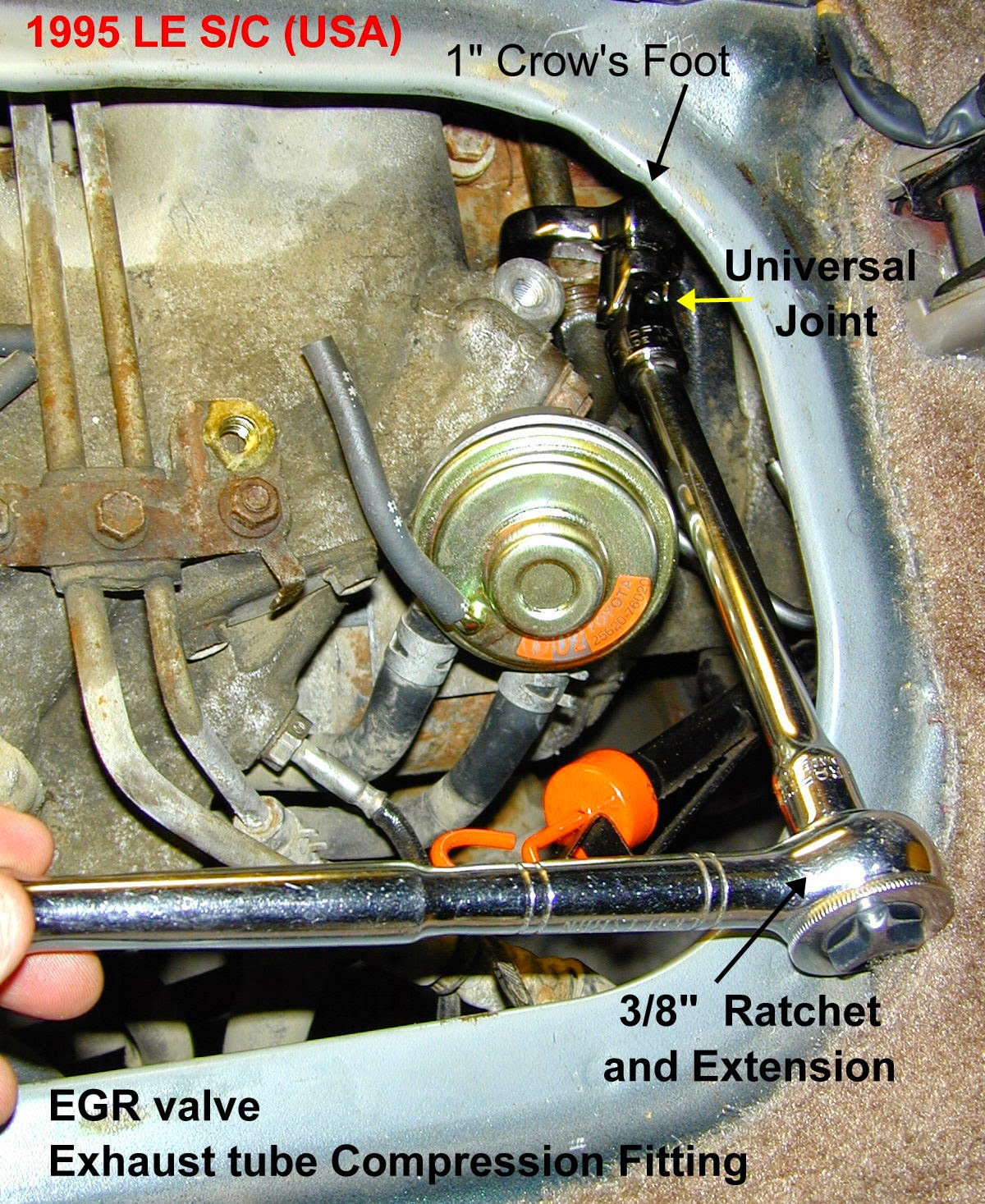










Thanks so much for posting this. How long did this process take you? My 95 Previa has the same issue, a code 0401. I'm deciding whether to do the work myself or have a mechanic do it.
ReplyDelete